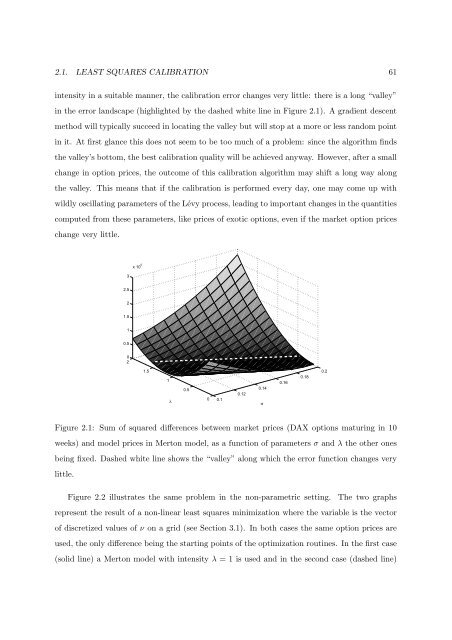Processus de Lévy en Finance - Laboratoire de Probabilités et ...
Processus de Lévy en Finance - Laboratoire de Probabilités et ...
Processus de Lévy en Finance - Laboratoire de Probabilités et ...
You also want an ePaper? Increase the reach of your titles
YUMPU automatically turns print PDFs into web optimized ePapers that Google loves.
2.1. LEAST SQUARES CALIBRATION 61<br />
int<strong>en</strong>sity in a suitable manner, the calibration error changes very little: there is a long “valley”<br />
in the error landscape (highlighted by the dashed white line in Figure 2.1). A gradi<strong>en</strong>t <strong>de</strong>sc<strong>en</strong>t<br />
m<strong>et</strong>hod will typically succeed in locating the valley but will stop at a more or less random point<br />
in it. At first glance this does not seem to be too much of a problem: since the algorithm finds<br />
the valley’s bottom, the best calibration quality will be achieved anyway. However, after a small<br />
change in option prices, the outcome of this calibration algorithm may shift a long way along<br />
the valley. This means that if the calibration is performed every day, one may come up with<br />
wildly oscillating param<strong>et</strong>ers of the Lévy process, leading to important changes in the quantities<br />
computed from these param<strong>et</strong>ers, like prices of exotic options, ev<strong>en</strong> if the mark<strong>et</strong> option prices<br />
change very little.<br />
3<br />
x 10 5<br />
2.5<br />
2<br />
1.5<br />
1<br />
0.5<br />
0<br />
2<br />
1.5<br />
1<br />
λ<br />
0.5<br />
0<br />
0.1<br />
0.12<br />
0.14<br />
σ<br />
0.16<br />
0.18<br />
0.2<br />
Figure 2.1: Sum of squared differ<strong>en</strong>ces b<strong>et</strong>we<strong>en</strong> mark<strong>et</strong> prices (DAX options maturing in 10<br />
weeks) and mo<strong>de</strong>l prices in Merton mo<strong>de</strong>l, as a function of param<strong>et</strong>ers σ and λ the other ones<br />
being fixed. Dashed white line shows the “valley” along which the error function changes very<br />
little.<br />
Figure 2.2 illustrates the same problem in the non-param<strong>et</strong>ric s<strong>et</strong>ting. The two graphs<br />
repres<strong>en</strong>t the result of a non-linear least squares minimization where the variable is the vector<br />
of discr<strong>et</strong>ized values of ν on a grid (see Section 3.1). In both cases the same option prices are<br />
used, the only differ<strong>en</strong>ce being the starting points of the optimization routines. In the first case<br />
(solid line) a Merton mo<strong>de</strong>l with int<strong>en</strong>sity λ = 1 is used and in the second case (dashed line)
















